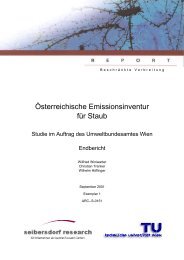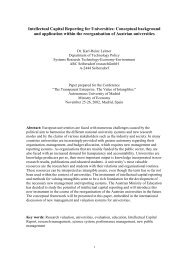ALPMON FINAL REPORT - ARC systems research
ALPMON FINAL REPORT - ARC systems research
ALPMON FINAL REPORT - ARC systems research
Create successful ePaper yourself
Turn your PDF publications into a flip-book with our unique Google optimized e-Paper software.
Contract ENV4-CT96-0359 <strong>ALPMON</strong><br />
program is the ERDAS *.gis format. The header of this image format is interpreted by a structure,<br />
provided in the include file head.h.<br />
Application of the post-classification algorithm will lead to patches that might still be smaller than the<br />
minimum mapping unit (although it is likely that they will be larger than the patches in the original<br />
classification). By simply shrinking these areas a lot of information would be lost. Therefore a second<br />
generalisation process is needed after the post-classification. This is achieved by applying an iterative<br />
shrinking process that affects only the regions originally smaller than the minimum mapping unit, while<br />
the larger ones are not changed at all. First all regions smaller than a certain threshold are shrunk<br />
leading to increasing larger regions at the expense of the smallest ones. In the following iterations this<br />
process is repeated applying an increased threshold until the threshold equals the desired minimal<br />
mapping unit. Performing this iterative process will lead to a generalised map without loosing<br />
significant information.<br />
2.3.6.4 Results<br />
The process of post-classification and subsequent iterative shrinking was applied to the classification<br />
results of all test sites. In order to show the effect of this process both the original classifications and<br />
the resulting generalised maps were compared to the respective CORINE land cover maps. Visual<br />
comparison was performed by means of maps, while a numerical comparison was based on confusion<br />
matrices (for details see report on WP 12). Looking at the results of the comparison a general trend<br />
can be seen. While the agreement between the original classifications and the CORINE land cover<br />
maps is relatively low, it increases significantly after the application of the post-classification process<br />
(Table 13). In all test sites the post-classified images have a higher agreement with the CORINE land<br />
cover maps. This effect is due to the increased level of generalisation that is provided by the postclassified<br />
images. In addition there is a significant increase of agreement when reducing the degree of<br />
thematic detail in the CORINE land cover maps by aggregating to level 2 (15 classes ) and level 1 (5<br />
classes). This indicates that the major confusion between the maps result from detailed thematic<br />
differences, that are likely to be caused by misinterpretation/-classification and differences in<br />
nomenclatures. A detailed analysis of the confusion between the data sets can be found in the report<br />
on work package 12.<br />
Table 13: Agreement between CORINE land cover maps and <strong>ALPMON</strong> results<br />
Test sites Dachstein Tarvisio Cordevole Mangfall Engadine<br />
<strong>ALPMON</strong> classification, agreement with<br />
CORINE Level 3 53% 45% 62% 29% n.a.<br />
CORINE Level 2 62% 78% 68% 64% 55%<br />
CORINE Level 1 79% 83% 93% 88% 68%<br />
<strong>ALPMON</strong> post-classification, agreement with<br />
CORINE Level 3 64% 53% 66% 40% n.a.<br />
CORINE Level 2 70% 84% 72% 67% 58%<br />
CORINE Level 1 88% 86% 93% 90% 72%<br />
2.3.6.5 Evaluation by the customer<br />
The agreement between the original classifications and the CORINE land cover maps of the test sites<br />
has been less than 50% in average. This “poor” agreement is partly due to the different degrees of<br />
generalisation of the land cover maps. While in CORINE the minimum mapping unit is 25 ha ( =<br />
250000 m 2 ), the <strong>ALPMON</strong> classifications refer to the single pixel, i.e. an area between 25 m 2 and 900<br />
m 2 depending on the image data applied. In order to overcome this contradiction of scale the <strong>ALPMON</strong><br />
classification results were post-processed using an generalisation technique. This technique allows to<br />
combine neighbouring pixels of different classes to larger objects of one heterogeneous class.<br />
Generalisation of the <strong>ALPMON</strong> classifications has its clear impact on the degree of agreement that<br />
could be increased by post-processing to almost 60% in average. Although an increase of 10% can be<br />
considered significant, and proves the effectiveness of the post-processing method, there is still about<br />
40% of confusion between the data sets that have to be explained. A part of it might be caused by the<br />
JR, RSDE, ALU, LMU, Seibersdorf, WSL 62




